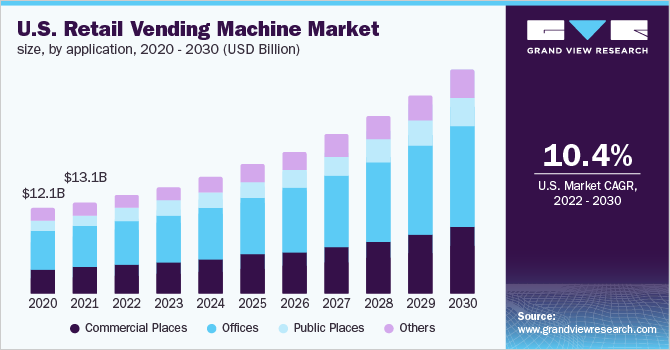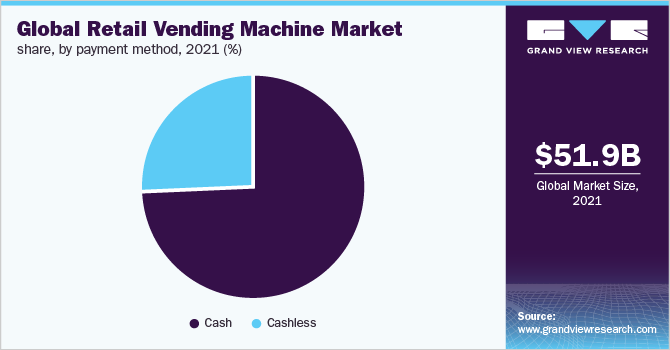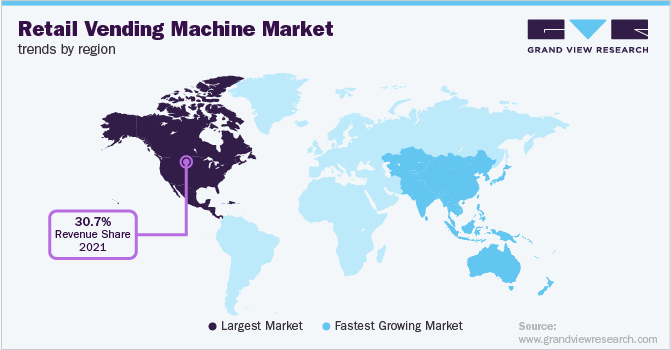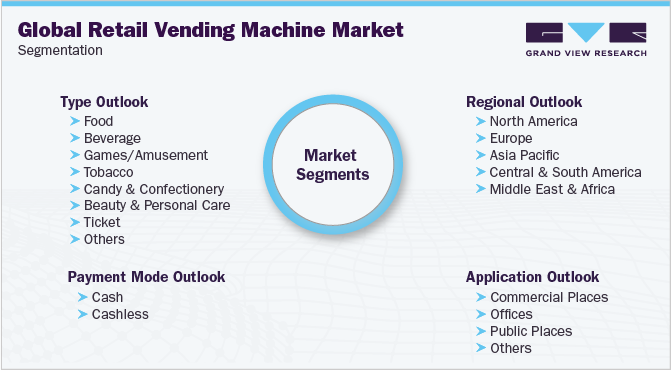- Home
- »
- Electronic & Electrical
- »
-
Retail Vending Machine Market Size & Trends Report, 2030GVR Report cover
![Retail Vending Machine Market Size, Share & Trends Report]()
Retail Vending Machine Market Size, Share & Trends Analysis Report By Type (Beverage, Food Vending Machines), By Payment Mode (Cash, Cashless), By Application (Offices, Public Places), And Segment Forecasts, 2022 - 2030
- Report ID: GVR-3-68038-465-9
- Number of Pages: 100
- Format: Electronic (PDF)
- Historical Range: 2017 - 2020
- Industry: Consumer Goods
Report Overview
The global retail vending machine market size was valued at USD 51.91 billion in 2021 and is expected to register a compound annual growth rate (CAGR) of 10.7% from 2022 to 2030. Increasing demand for on-the-go snacks and beverages due to the hectic lifestyles of consumers is boosting product sales through vending machines. The industry growth can also be attributed to the ability of these machines to deliver goods quickly, making it an extremely convenient option for consumers. From offices to high-end restaurants and crowded bars to public places, accessing food & beverage items is made simple with a vending machine. This, in turn, is likely to drive their demand.

The coronavirus pandemic has unfavorably influenced the consumer goods industry with lockdowns having an impact across the supply chain. The impact on food and beverage companies will likely be complex, influencing both the demand and supply. In contrast, a change in consumer behavior has been observed, generating demand for various consumer goods, wherein several consumers have switched between brands. Simultaneously, manufacturers are deciding on how to handle potential disruption across the supply chain and are identifying areas to improve and meet consumer demand. Vending machine operators have witnessed the impact and a fall in revenue, especially in April 2020 as compared to 2019.
Sales through vending machines look promising as vending machines not just offer snacks and beverages but can also sell other consumables, such as cigarettes and lottery tickets. Hence, operators can generate significant revenue through these devices by strategically placing them in corporate buildings, schools, malls, train stations, and airports, among others. For instance, in August 2019, it was announced that over 1 million plastic bottles had been recycled through reverse vending machines in Iceland stores. The healthy lifestyle trend is becoming increasingly prominent across the globe on account of growing consumer awareness regarding healthy food and beverage options.
According to 2019 research by The Vending People, the sales of zero-sugar beverages surged by 38.2% from the first half of 2018 to the first half of 2019, in the U.K., while sales of high-sugar content beverages have seen the biggest drop. Sales of these drinks were down by 19.8% when compared to the same timespan the previous year. Low-calorie drinks outsold other beverages by 196%, showing that customers are looking for healthier alternatives.
Type Insights
The beverage retail vending machine segment dominated the industry in 2021 and accounted for the maximum share of more than 43.00% of the global revenue. The high demand for coffee and energy drinks across various sectors is driving the growth of this segment. Beverage vending machines not only consist of coffee, tea, or cocoa, but also have diet soda, energy drinks, lemonade, flavored drinks, vitamin water, and water bottles. Beverage vending machines are immensely popular in hotels for guests who prefer a beverage or a small snack instead of a full meal. Vending machines are often placed in the lobby of a hotel to generate continuous revenue.
The beauty & personal care retail vending machine segment is projected to grow at the fastest CAGR during the forecast period. Shaving creams, deodorants, and makeup removers are among the products available in beauty & personal care vending machines. These vending machines are commonly installed in shopping malls, spas, barber shops, and airports in major cities. They are also an alternative for customers who normally shop online for luxury beauty and skincare products. Increasing footfall in spas, airports, and shopping malls is expected to fuel the demand for beauty and personal care retail vending machines.
Payment Mode Insights
In 2021, the cash payment mode segment dominated the global industry and accounted for the maximum share of more than 74.00%of the overall revenue. The segment is projected to expand further at a significant CAGR retaining its leading market position throughout the forecast period. Cash and credit cards can be used interchangeably at retail vending machines. Customers can utilize either of the methods depending on the availability of resources because vending machines often contain a slot for cash and another for cards. It is ultimately up to the buyer to select a payment method.

According to a report published by Mercator Advisory Group, only one-third of vending machines in the U.S. accepted cashless payments over the majority of the last decade. Also, retail vending machines available in rural regions prefer cash rather than cashless modes of payment. The cashless payment mode segment is estimated to witness a faster CAGR over the forecasted period. Cashless payment provides various advantages for both customers and companies, making it more than simply a commodity.
Advantages, such as less cash handling losses, saving extra cost and labor time, and speed & efficiency in the transaction, are expected to drive cashless payment modes. Also, people prefer the cashless or contactless method as it is considered to be a more hygienic way to make payments. For instance, according to a survey by MasterCard in April 2020, 82% of respondents worldwide said they preferred contactless and cashless payments as a cleaner way to pay.
Application Insights
In 2021, the offices' segment held the largest revenue share of 42.7% and is expected to maintain its dominance over the forecast period. Vending machines are installed in workplaces to offer employees a convenient, affordable, and quick option for buying food. The introduction of vending machines has aided businesses in easily and automatically distributing things directly at the workplace. The retail vending machines also offer a variety of things to help employees with their daily work routine. It can offer beverages, snacks, high-energy meals, or other workplace supplies.
Individuals can also purchase phone cards directly from the retail vending machine. It is possible to pay for such items through cash, mobile apps, a bank card, or an e-wallet. The commercial segment is estimated to witness a significant CAGR over the forecast period. Vending machines are seen as a resolution to labor shortages. Costs associated with a retail vending machine are less than costs incurred by an unattended retail shop. Vending machines can provide convenience store operators with the option to explore new avenues and opportunities in an otherwise crowded sector. These devices can accept a variety of payment cards as well as mobile payments.
Regional Insights
Based on geographies, the global industry has been further categorized into North America, Asia Pacific, Middle East & Africa, Europe, and Central & South America. North America dominated the global industry in 2021 and accounted for the highest share of more than 30.7% of the overall revenue. The region is projected to expand further at a steady CAGR maintaining its dominant position throughout the forecast period. The rise of self-service technology in this region has created new business avenues for retail vending machines. Therefore, several retail vending machine operators are focusing on launching their businesses in strategic locations across the region.

Asia Pacific, on the other hand, is anticipated to register the fastest growth rate during the forecast period. The region’s growth can be mainly attributed to the high product penetration in major countries, such as Japan and Singapore, due to rising population. Developing economies in the Asia Pacific region, such as India and China, also present strong growth potential for the industry. Europe is also estimated to witness significant growth registering the second-fastest CAGR during the forecast years. However, the MEA region is estimated to have a slightly sluggish growth compared to other regions.
Key Companies & Market Share Insights
Operators are adopting various strategies to maximize profit by being at the right location with the right products, sourcing products in bulk, investing in intelligent vending machines to gain consumer insights, and other ways. For instance, hot food and sandwich vending machines may do well in business environments, universities, and schools, while, in most public locations, hot drinks like coffee, tea, and hot chocolate have high demand. Industry players face intense competition from each other, as some of them operate at several locations and have large customer bases. The presence of many small-scale players is also leading to increased competition.
-
In 2021, Coca-Cola Beverages Florida (Coke Florida) and Coca-Cola Co. teamed up to launch a new Reverse Vending Machine (RVM) at the University of Miami. The materials are crushed and sorted by type, then collected, treated, and prepared for re-use. The process ultimately reduces carbon emissions across the supply chain and supports Coca-Cola’s World Without Waste initiative to recycle a bottle or can sold by 2030
-
In 2022, under the CSR initiative to curb carbon footprint, the Small Industries Development Bank of India (SIDBI) and the Dalit Indian Chamber of Commerce and Industries (DICCI) jointly announced the installation of 1,000 Plastic Reverse Vending Machines (RVMSs). The launch was announced under the ‘Swachh Delhi, Swavalambi Delhi’ initiative. The RVMs will be installed at as many public places like malls, metro stations, and parks as possible
-
In 2021, the MENstruation Foundation, a nonprofit organization that fights “period poverty”, introduced a sanitary pad vending machine, the first in Africa. The pads are locally manufactured and compostable. The foundation says that it aims to reach at least 100 schools by 2022 and hopes to double that in the years to come. Support from the corporate sector-such as MTN, which has sponsored two machines-was crucial
Some of the key players operating in the global retail vending machine market include:
-
Azkoyen Group
-
Cantaloupe Systems
-
Westomatic Vending Services Limited
-
Royal Vendors, Inc.
-
Glory Ltd.
-
Sanden Holding Corp.
-
Seaga Manufacturing Inc.
-
Orasesta S.p.A
-
Sellmat s.r.l.
-
Fuji Electric Co., Ltd.
Retail Vending Machine Market Report Scope
Report Attribute
Details
Market size value in 2022
USD 56.28 billion
Revenue forecast in 2030
USD 129.40 billion
Growth rate
CAGR of 10.7% from 2022 to 2030
Base year for estimation
2021
Historical data
2017 - 2020
Forecast period
2022 - 2030
Quantitative units
Revenue in USD million/billion and CAGR from 2022 to 2030
Report coverage
Revenue forecast, company ranking, competitive landscape, growth factors, and trends
Segments covered
Type, application, payment mode, region
Regional scope
North America; Europe; Asia Pacific; Central & South America; Middle East & Africa
Country scope
U.S.; Canada; Germany; U.K.; France; China; India; Japan; Brazil; Argentina; UAE; South Africa
Key companies profiled
Azkoyen Group; Cantaloupe Systems; Westomatic Vending Services Limited; Royal Vendors, Inc.; Glory Ltd.; Sanden Holding Corp.; Seaga Manufacturing Inc.; Orasesta S.p.A.; Sellmat s.r.l.; Fuji Electric Co., Ltd.
Customization scope
Free report customization (equivalent to up to 8 analysts' working days) with purchase. Addition or alteration to country, regional & segment scope.
Pricing and purchase options
Avail of customized purchase options to meet your exact research needs. Explore purchase options
Global Retail Vending Machine Market Segmentation
This report forecasts revenue growth at global, regional, and country levels and provides an analysis of the latest industry trends in each of the sub-segments from 2017 to 2030. For this study, Grand View Research has segmented the global retail vending machine market report based on type, payment mode, application, and region:

-
Type Outlook (Revenue, USD Million, 2017 - 2030)
-
Food
-
Beverage
-
Games/Amusement
-
Tobacco
-
Candy & Confectionery
-
Beauty & Personal Care
-
Ticket
-
Others (Ice-cream Vending Machines, Pharmacy, Vending Machine, etc.)
-
-
Payment Mode Outlook (Revenue, USD Million, 2017 - 2030)
-
Cash
-
Cashless
-
-
Application Outlook (Revenue, USD Million, 2017 - 2030)
-
Commercial Places
-
Offices
-
Public Places
-
Others
-
-
Regional Outlook (Revenue, USD Million, 2017 - 2030)
-
North America
-
U.S.
-
Canada
-
-
Europe
-
Germany
-
U.K.
-
France
-
-
Asia Pacific
-
China
-
Japan
-
India
-
-
Central & South America
-
Brazil
-
Argentina
-
-
Middle East & Africa
-
South Africa
-
UAE
-
-
Frequently Asked Questions About This Report
b. The global retail vending machine market size was estimated at USD 51.91 billion in 2021 and is expected to reach USD 56.28 billion in 2022.
b. The global retail vending machine market is expected to grow at a compound annual growth rate of 10.7% from 2022 to 2030 to reach USD 129.40 billion by 2030.
b. North America region dominated the global retail vending machine market with a share of 31% in 2021. This is attributable to the changing lifestyles and high demand for Ready-to-Eat (RTE) products.
b. Some key players operating in the global retail vending machine market include Azkoyen Group; Cantaloupe Systems; Westomatic Vending Services Limited; Royal Vendors, Inc.; Glory Ltd.; Sanden Holding Corp.; Seaga Manufacturing Inc.; Orasesta S.p.A.; Sellmat s.r.l.; and Fuji Electric Co., Ltd.
b. Key factors that are driving the retail vending machine market growth include growing demand for on-the-go snacks, drinks, etc. due to hectic lifestyles and machines' ability to deliver goods quickly making it an extremely convenient option for consumers.
Share this report with your colleague or friend.
![gvr icn]()
NEED A CUSTOM REPORT?
We can customize every report - free of charge - including purchasing stand-alone sections or country-level reports, as well as offer affordable discounts for start-ups & universities. Contact us now
![Certified Icon]()
We are GDPR and CCPA compliant! Your transaction & personal information is safe and secure. For more details, please read our privacy policy.
We are committed towards customer satisfaction, and quality service.
"The quality of research they have done for us has been excellent."





